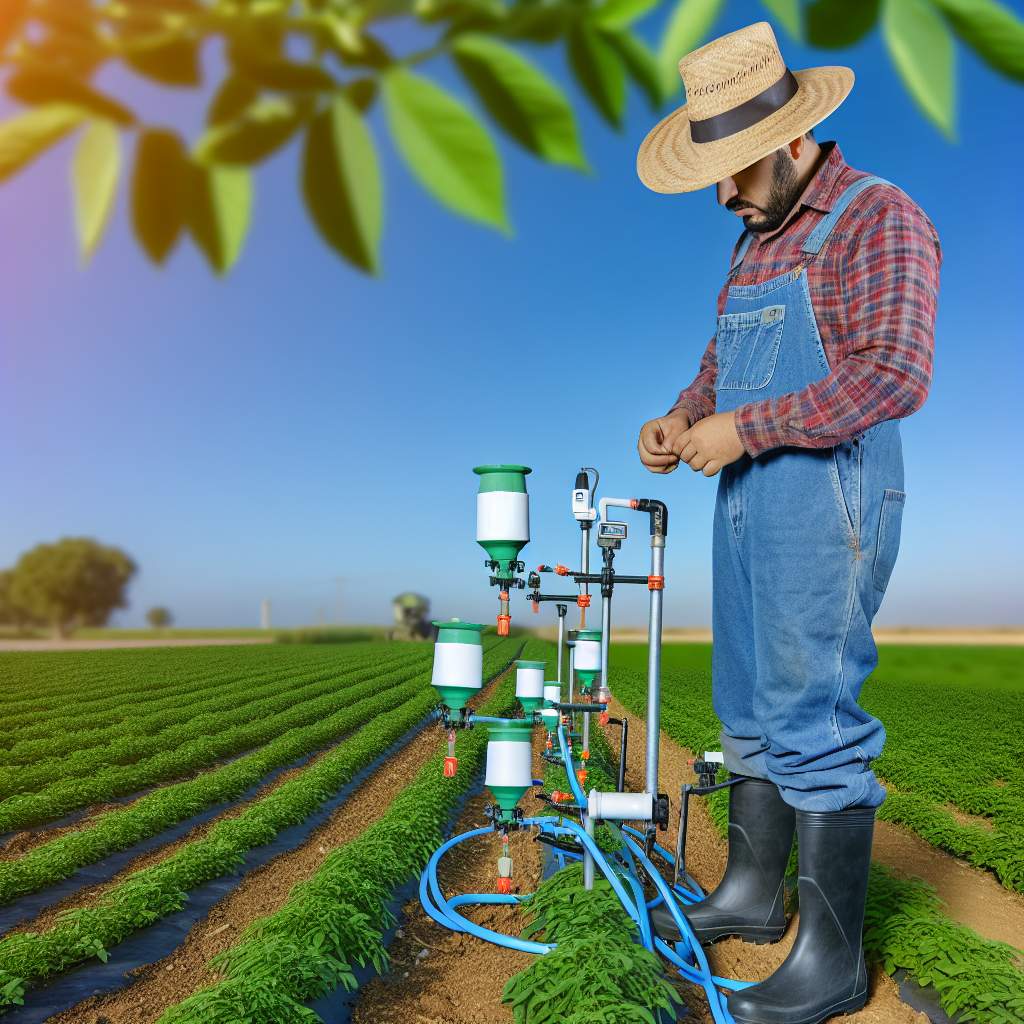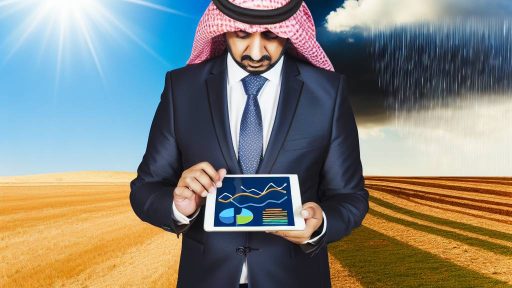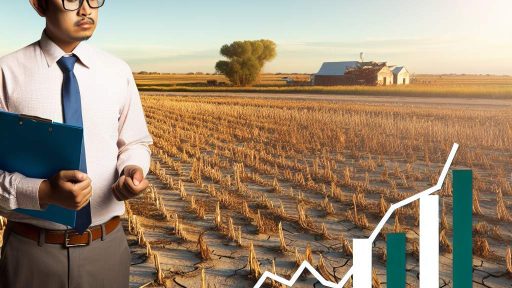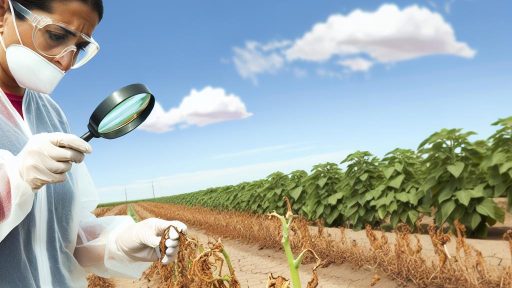Introduction to Sustainable Irrigation
Sustainable irrigation is essential for modern agriculture.
It plays a critical role in water conservation efforts.
Effective water management practices are crucial for farming success.
Therefore, farmers must adopt sustainable irrigation methods.
The Importance of Water Conservation
Water scarcity poses a significant threat to agriculture.
Conserving water enhances crop yields and reduces costs.
Moreover, efficient irrigation reduces environmental impacts.
This practice helps to preserve local water supplies.
Additionally, it supports sustainable land management practices.
Benefits of Sustainable Irrigation Practices
Sustainable irrigation techniques offer numerous advantages.
- They improve water efficiency and reduce waste.
- These methods enhance soil health and fertility.
- They contribute to biodiversity in agricultural landscapes.
- Sustainable practices reduce reliance on chemical fertilizers.
Ultimately, these benefits contribute to healthier ecosystems.
Challenges in Implementing Sustainable Irrigation
Despite the benefits, challenges exist in adopting these practices.
Farmers often face economic constraints in transitioning systems.
Additionally, knowledge gaps may hinder effective implementation.
Support from agricultural organizations can facilitate change.
Transform Your Agribusiness
Unlock your farm's potential with expert advice tailored to your needs. Get actionable steps that drive real results.
Get StartedTraining programs help farmers learn and adapt sustainable techniques.
Types of Sustainable Irrigation Practices in Agriculture
Drip Irrigation
Drip irrigation delivers water directly to the plant roots.
This method reduces evaporation and runoff.
Farmers save significant amounts of water with this technique.
Additionally, it minimizes the growth of weeds.
Consequently, it reduces the need for herbicides.
Rainwater Harvesting
Rainwater harvesting captures and stores rain for agricultural use.
This practice enhances water availability during dry periods.
Farmers can implement various storage systems, like tanks and ponds.
Moreover, it helps reduce reliance on groundwater sources.
This method contributes to sustainable ecosystem management.
Soil Moisture Sensors
Soil moisture sensors provide real-time data on soil moisture levels.
Farmers can use this data to optimize their irrigation schedules.
This technology helps prevent overwatering and underwatering.
As a result, it promotes water conservation in agriculture.
Moreover, it improves crop yields through better moisture management.
Mulching
Mulching involves applying a layer of material on the soil surface.
This practice conserves soil moisture by reducing evaporation.
Organic materials, such as straw or wood chips, are commonly used.
Additionally, mulching suppresses weed growth.
Consequently, it lowers the need for chemical weeding agents.
Subsurface Irrigation
Subsurface irrigation systems place water below the soil surface.
This method reduces evaporation and water loss significantly.
Farmers can utilize tubing systems to ensure efficient delivery.
Showcase Your Farming Business
Publish your professional farming services profile on our blog for a one-time fee of $200 and reach a dedicated audience of farmers and agribusiness owners.
Publish Your ProfileAdditionally, it minimizes surface runoff and erosion.
As a result, it promotes healthier root systems in plants.
Benefits of Drip Irrigation for Water Efficiency and Crop Yield
Understanding Drip Irrigation
Drip irrigation delivers water directly to plant roots.
This system minimizes evaporation and runoff.
Consequently, it significantly enhances water efficiency.
Enhancing Water Efficiency
Drip irrigation systems use water more effectively.
They apply water at low rates per hour.
This method reduces overall water consumption.
Farmers can optimize water use even in dry conditions.
Moreover, it limits weed growth by irrigating only the plants.
Improving Crop Yield
With drip irrigation, crops receive consistent moisture.
This uniformity leads to healthier plants and higher yields.
Additionally, it allows for precise nutrient application.
Farmers can improve soil fertility through targeted fertilizer use.
As a result, crops thrive and produce better harvests.
Reducing Labor and Maintenance Costs
Drip irrigation systems require less labor than traditional methods.
Farmers spend less time managing water resources.
Furthermore, these systems often have lower maintenance needs.
This results in cost savings over the long term.
Environmental Impact
Using drip irrigation reduces environmental degradation.
It minimizes water wastage and prevents soil erosion.
This approach supports sustainable farming practices.
Consequently, it contributes to preserving natural resources.
See Related Content: How Biodiversity and Agroforestry Impact Property Resale Values
The Role of Rainwater Harvesting in Sustainable Irrigation Systems
Introduction to Rainwater Harvesting
Rainwater harvesting captures and stores rainwater for future use.
This practice effectively reduces reliance on traditional water sources.
Farmers can utilize harvested rainwater to irrigate their crops.
Benefits of Rainwater Harvesting
This method promotes water conservation in agriculture.
It helps mitigate the impacts of droughts and water shortages.
Moreover, it reduces soil erosion and runoff.
Farmers benefit from lower water bills and reduced irrigation costs.
Implementing Rainwater Harvesting Systems
Successful implementation requires careful planning and design.
Farmers should assess their land and rainfall patterns.
Identifying suitable storage solutions is crucial for success.
For instance, tanks or ponds can serve as effective storage options.
Best Practices for Effective Rainwater Harvesting
- Install gutters and downspouts to collect rainwater efficiently.
- Use filtration systems to ensure water quality.
- Regularly maintain storage systems to prevent contamination.
Furthermore, integrating this system with existing irrigation practices is beneficial.
Challenges and Solutions
Despite its benefits, rainwater harvesting faces several challenges.
Seasonal rainfall variability can impact water availability.
Farmers can address this issue by combining rainwater with other water sources.
Additionally, awareness programs can educate farmers on the benefits.
Showcase Your Farming Business
Publish your professional farming services profile on our blog for a one-time fee of $200 and reach a dedicated audience of farmers and agribusiness owners.
Publish Your ProfilePromoting Sustainable Agriculture through Rainwater Harvesting
Rainwater harvesting plays a vital role in sustainable irrigation.
It fosters water conservation while supporting agricultural productivity.
This approach benefits farmers and promotes environmental health.
Learn More: How Flooding Impacts Agricultural Property Values in the USA
Soil Moisture Management Techniques
Understanding Soil Moisture
Soil moisture plays a critical role in agriculture.
It affects crop growth, yields, and overall health.
Farmers must monitor moisture levels closely.
Understanding local soil types can enhance moisture management.
Importance of Soil Moisture Monitoring
Regular monitoring helps farmers make informed decisions.
It optimizes irrigation schedules and reduces water wastage.
Farmers can use various tools for accurate measurements.
Soil moisture sensors provide real-time data.
Techniques for Effective Management
Implementing effective moisture management techniques is essential.
Crop rotation can improve soil structure and moisture retention.
Cover crops also aid in maintaining moisture levels.
They prevent evaporation and protect against erosion.
Utilizing Technology in Soil Moisture Management
Technology has transformed soil moisture management practices.
Remote sensing and drones offer innovative solutions.
Farmers can map moisture levels across fields efficiently.
This technology allows for precision irrigation strategies.
Benefits of Sustainable Moisture Management
Using sustainable practices ensures better water conservation.
It promotes healthier crops and improved yield quality.
Additionally, it can lead to reduced operational costs.
Farmers benefit from sustainable approaches while protecting resources.
Implementing Soil Moisture Management Practices
Farmers should start with simple practices that make an impact.
Incorporating mulching can help retain soil moisture.
Adjusting planting times to align with rainfall patterns is effective.
Education and training programs can support these initiatives.
Uncover the Details: Understanding Soil Health Regulations and Their Impact on Farmland
Comparative Analysis of Traditional vs. Modern Irrigation Methods
Overview of Traditional Irrigation Methods
Traditional irrigation methods have a long history in agriculture.
These techniques often rely on gravity to move water.
Surface irrigation is one common approach.
This method involves flooding fields directly.
It works well for certain crops and landscapes.
However, it can waste a significant amount of water.
Additionally, it leads to soil erosion and nutrient depletion.
Limitations of Traditional Methods
Traditional irrigation practices often lack efficiency.
High evaporation rates can occur, especially in warm climates.
Moreover, water distribution may be uneven across fields.
This inconsistency affects crop yields negatively.
Showcase Your Farming Business
Publish your professional farming services profile on our blog for a one-time fee of $200 and reach a dedicated audience of farmers and agribusiness owners.
Publish Your ProfileFarmers face challenges in managing water resources.
As a result, these methods may not support sustainable agriculture.
Introduction to Modern Irrigation Techniques
Modern irrigation techniques emerged as a solution to previous limitations.
These methods prioritize water use efficiency.
Drip irrigation is a prime example of modern technology.
It delivers water directly to plant roots through a network of tubes.
This targeted approach minimizes evaporation and runoff.
Benefits of Modern Irrigation Practices
Modern methods significantly conserve water resources.
They improve crop yields by ensuring optimal moisture levels.
Additionally, these techniques reduce labor costs over time.
Farmers can automate systems for greater convenience.
Data-driven technologies also enable precise water management.
Comparative Efficiency
When comparing traditional and modern methods, efficiency is key.
Modern irrigation systems can use 30-50% less water than traditional ones.
This reduction supports water conservation efforts worldwide.
Furthermore, these technologies are adaptable to diverse climates.
Farmers can customize systems based on specific crop needs.
Implications of Embracing Modern Technology
The shift towards modern irrigation practices is gaining momentum.
Farmers increasingly recognize the importance of sustainability.
As a result, investing in irrigation technology is becoming common.
Governments and organizations support this transition through funding.
Ultimately, embracing modern methods will lead to better water management.
Learn More: The Role of Agroforestry in Increasing Biodiversity on Farmland Estates

Economic Benefits of Adopting Sustainable Irrigation Practices
Cost Savings on Water Usage
Sustainable irrigation practices reduce water consumption significantly.
This leads to lower utility bills for farmers.
Consequently, this practice directly impacts overall profitability.
Enhanced Crop Yields
Efficient irrigation systems boost crop productivity.
When crops receive the right amount of water, they thrive.
As a result, farmers can enjoy higher yields and better quality produce.
Access to Financial Incentives
Many governments offer financial incentives for sustainable practices.
These incentives may include grants, tax breaks, or low-interest loans.
By adopting sustainable irrigation, farmers can leverage these benefits.
Increased Market Potential
Consumers increasingly prefer sustainably produced goods.
By implementing these practices, farmers can tap into higher-value markets.
This shift often results in better pricing for their products.
Long-Term Soil Health
Sustainable irrigation enhances soil structure and fertility.
Healthy soil leads to improved crop resilience.
Over time, this investment creates a more sustainable farming system.
Community and Environmental Benefits
Adopting sustainable irrigation practices benefits local communities.
It promotes stewardship of natural resources and enhances local ecosystems.
Showcase Your Farming Business
Publish your professional farming services profile on our blog for a one-time fee of $200 and reach a dedicated audience of farmers and agribusiness owners.
Publish Your ProfileThus, farmers contribute to the overall health of their communities.
Case Studies: Successful Implementations of Sustainable Irrigation Worldwide
Innovative Techniques in Australia
Australia has faced severe droughts in recent years.
In response, farmers have adopted advanced irrigation techniques.
Systems using drip irrigation have become increasingly popular.
This approach has significantly reduced water wastage.
Farmers like Emily Johnson have reported improved crop yields.
Moreover, these techniques support the sustainability of local ecosystems.
Traditional Practices in India
In India, traditional irrigation methods are being revitalized.
The use of rainwater harvesting systems has gained traction.
Farmers in Rajasthan have successfully implemented these systems.
This method helps to store seasonal rains for later use.
As a result, they have increased their agricultural resilience.
Furthermore, it reduces dependence on groundwater sources.
Technological Integration in the United States
American farmers are utilizing technology to enhance irrigation efficiency.
Precision agriculture tools are now commonplace in many states.
These tools monitor soil moisture levels more accurately.
Farmers like Sarah Thompson have embraced these technologies.
This approach has led to a significant reduction in water consumption.
Thus, sustainable practices are now integral to modern agriculture.
Community Engagement in Mexico
Community-driven irrigation initiatives have emerged in Mexico.
Local groups in the Oaxaca region focus on cooperative water usage.
They promote equitable water distribution among farmers.
This method fosters collaboration and resource sharing.
Additionally, it optimizes the use of available water resources.
Ultimately, these practices enhance community resilience to climate change.
Lessons Learned from Israel
Israel is renowned for its innovative irrigation solutions.
The country has pioneered drip irrigation technology over decades.
Farmers in Israel use sensors to gauge irrigation needs accurately.
This minimizes water usage while maximizing crop production.
Moreover, Israeli experts share their knowledge globally.
As a result, many countries benefit from Israel’s experiences.
Challenges and Solutions in Adopting Sustainable Irrigation Practices
Understanding the Current Challenges
Farmers face several challenges in adopting sustainable irrigation practices.
Water scarcity is a pressing concern in many regions.
Additionally, traditional irrigation methods are often deeply entrenched.
Farmers may also struggle with the costs of new technology.
Moreover, a lack of knowledge about sustainable practices can hinder implementation.
Technological Barriers
The adoption of new irrigation technology can be slow.
Many farmers are unfamiliar with advanced irrigation systems.
Consequently, they may resist changes due to perceived risks.
Training and education are essential to overcome these barriers.
Showcase Your Farming Business
Publish your professional farming services profile on our blog for a one-time fee of $200 and reach a dedicated audience of farmers and agribusiness owners.
Publish Your ProfileFinancial Constraints
Investing in sustainable irrigation practices can be expensive.
Farmers often lack access to funds for necessary upgrades.
Government subsidies can alleviate some of these financial burdens.
Grants from NGOs can also help support adoption costs.
Potential Solutions for Sustainable Practices
Education programs can increase awareness of sustainable irrigation.
Workshops and seminars can provide hands-on training.
Moreover, sharing success stories can inspire other farmers.
Implementation of New Technologies
Farmers can benefit from drip irrigation systems.
This method conserves water while providing adequate moisture.
Using moisture sensors can help optimize irrigation schedules.
Such technologies can lead to significant water savings.
Community Support and Collaboration
Building local networks fosters collaboration among farmers.
Sharing resources and knowledge can enhance success rates.
Community-based projects can also assist in funding initiatives.
Moreover, partnerships with universities can drive research and innovation.
The Role of Policy and Incentives
Government policies play a critical role in promoting sustainability.
Implementing incentives can motivate farmers to adopt new systems.
Tax breaks or subsidies can significantly support transitions.
Regulations encouraging sustainable practices can foster compliance.
Future Trends in Sustainable Irrigation Technology and Practices
Advancements in Precision Irrigation
Precision irrigation technologies enhance water use efficiency significantly.
These systems apply water based on real-time field conditions.
Technologies like soil moisture sensors help farmers optimize irrigation schedules.
Moreover, satellite imagery provides valuable data for decision-making.
As a result, farmers can reduce water wastage and improve crop yields.
Integrating Smart Technologies
Smart irrigation systems are gaining popularity in agriculture.
They utilize IoT devices to monitor and control water usage effectively.
This integration allows for remote management and automation of irrigation practices.
Farmers benefit from reduced labor costs and increased operational efficiency.
Furthermore, real-time data analysis can predict irrigation needs accurately.
Emphasizing Rainwater Harvesting
Rainwater harvesting is emerging as a vital practice in sustainable irrigation.
This technique collects and stores rainwater for agricultural use.
By using this stored water, farmers can alleviate dependency on groundwater.
Unequivocally, this practice contributes to better water conservation efforts.
Additionally, integrating rainwater harvesting with traditional systems offers multiple benefits.
Utilizing Drones for Irrigation Management
Drones are revolutionizing how farmers manage irrigation.
They provide aerial views of irrigation patterns and crop health.
Aerial imagery enables quick detection of problem areas in the fields.
This capability allows farmers to target interventions where they are most needed.
Consequently, drones enhance the efficiency of irrigation practices significantly.
Promoting Soil Health through Irrigation Practices
Healthy soil improves water retention and reduces irrigation needs.
Showcase Your Farming Business
Publish your professional farming services profile on our blog for a one-time fee of $200 and reach a dedicated audience of farmers and agribusiness owners.
Publish Your ProfileFarmers are focusing on practices that maintain soil structure and fertility.
Techniques like cover cropping and reduced tillage enhance soil health.
In addition, these practices promote beneficial microbial activity in the soil.
Ultimately, balanced soil health leads to sustainable crop production.
Additional Resources
Water Conservation in Agriculture – Nevada Irrigation District




